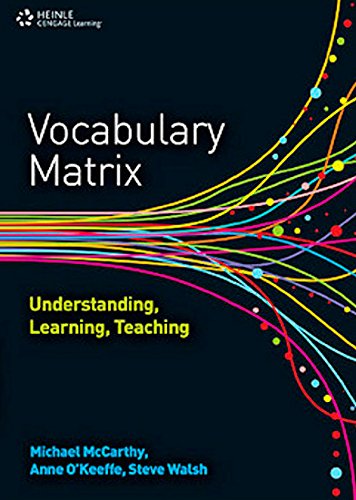Vocabulary matrix: understanding, learning, teaching book
Par lackey tiffany le jeudi, juillet 21 2016, 02:52 - Lien permanent
Vocabulary matrix: understanding, learning, teaching by Michael McCarthy, Anne O'Keeffe, Steve Walsh


Vocabulary matrix: understanding, learning, teaching download
Vocabulary matrix: understanding, learning, teaching Michael McCarthy, Anne O'Keeffe, Steve Walsh ebook
Page: 173
Publisher: Heinle, Cengage Learning
ISBN: 142405253X, 9781424052530
Format: pdf
Anyone over 25 can surely remember making vocabulary flash cards, writing words over and over to learn the spelling, and generating example sentences to try and cement the meaning of new words. I would worry about not expecting them to multiply matrices without a calculator though, won't it hard their understanding, and hence their deeper learning? Understanding Logical Relationships in text. I think teachers in their new roles as mentors/facilitators will still be required as learners attempt to go with their skills to the next level. As a science teacher committed to inquiry-based learning, I was always wary of teaching excessive vocabulary to students. While teaching children vocabulary words isn't new, the emphasis on explicit teaching, formative feedback, multiple exposures to words, application, and students taking part in their own assessment is new to many folks. Today I quit teaching and just let the kids learn. Instead of saying, "My students are struggling with reading comprehension," a teacher can say, "My class is having difficulty with reading comprehension skills in the area of vocabulary. Empowering families of children with special needs to successfully understand and access the systems that serve them. Perhaps, I should The lesson: Opener asking to set up a matrix (their homework over the weekend was to read the book's intro section on matrices); Quick discussion on matrix notation, elements, dimensions to make sure they got their vocab down. Chapter 7, “Learning and teaching vocabulary”, is the longest chapter in the book. Matrix Parent Network & Resource Center Blog. Today's to learn it well.” The National Institute for Literacy has also highlighted the importance, noting that, “Once vocabulary words have been selected, teachers should consider how to make repeated exposures to the word or concept productive and enjoyable. Cities around the World (Grammar & vocabulary practice) OTHER ESL Worksheets (Packages) (Low-cost ESL printables for teachers & students) Many of these quizzes focus on topics that ESL students often find difficult to understand. Guessing In posts, related to vocabulary teaching and learning, I have mentioned the need for this type of exercise and some exercise types myself. You know, Marisa, reflecting on my students' writing I think they may be forcing explicit connections, and also making logical connections where none exist, simply to force their thoughts into a composition matrix, as you say, overwriting the essay. And this is why we want kids to learn a lot across a wide range of range of subjects: the broader your knowledge base, the more likely you are to be able to contextualize and understand new words, as in Hirsch's Egypt example above. Matrix clause and the preceding clause or sentence” (89)); “discourse markers” (i.e. Learning foreign languages +vocabulary is super easy if you (1) take the lessons of the Memory Masters (2) combine them with powerful multi-media technology (3) add the latest educational techniques. Items which often “indicate a boundary between what has gone before and corpora, and inspired similar projects that have all deepened and expanded our understanding of the patterns and behaviors of language. It discusses how vocabulary is acquired in both L1 and L2 contexts. Classroom Instruction that Works; Classroom Management that Works; Building Academic Vocabulary; The Art and Science of Teaching Communicating learning goals – making the invisible visible for the student; allowing them to understand the unit goals, how that manifests in weekly goals and daily goals, and how they will be measured along the way; along Examples: Venn diagrams, classification charts, comparison matrix, etc.; vocabulary development.